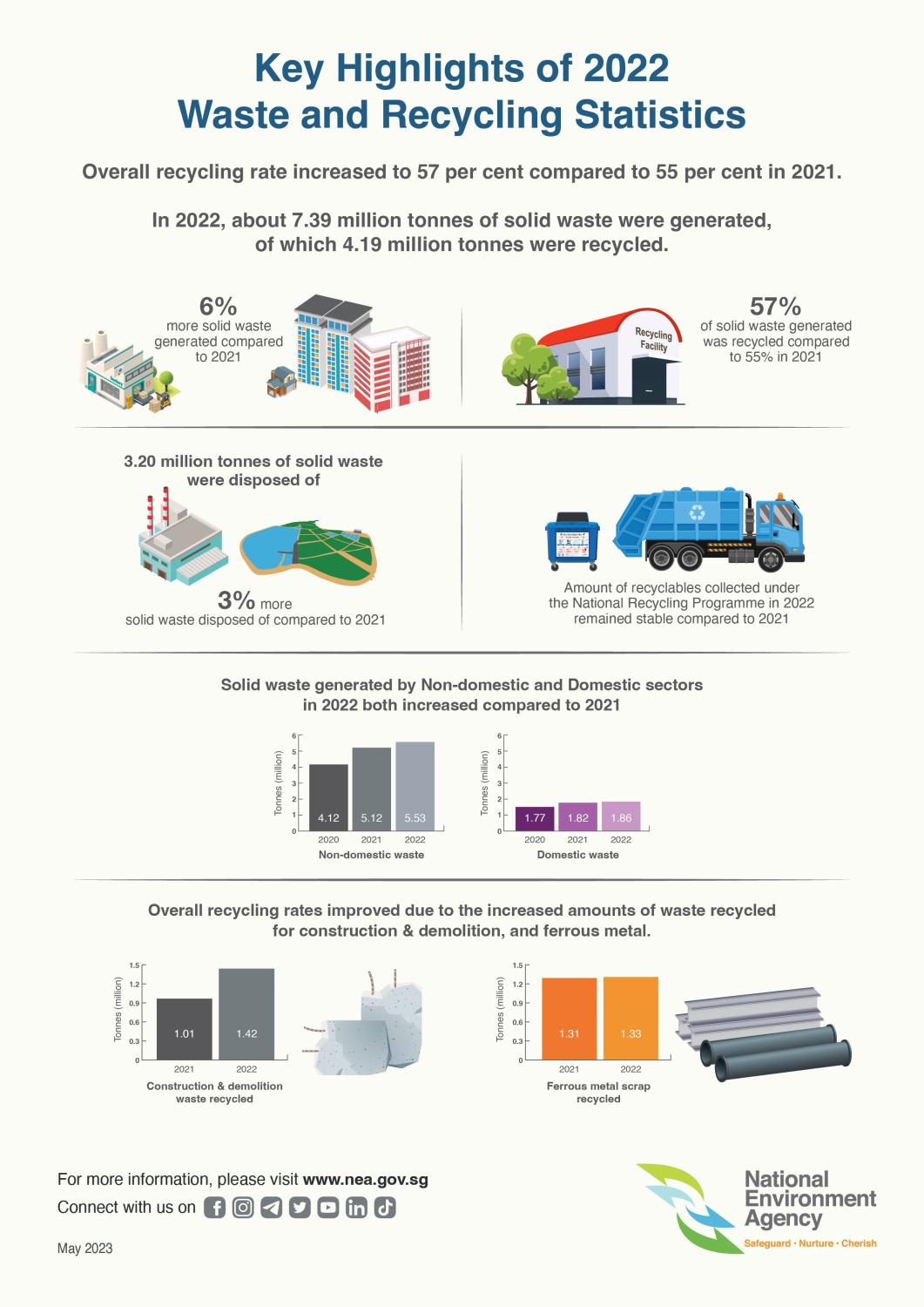About 6% more waste generated in Singapore in 2022; recycling rate increased slightly
The overall recycling rate rose to 57 per cent in 2022 compared with 55 per cent in 2021.
SINGAPORE: More waste was generated in Singapore in 2022, the second consecutive year of increase as economic activity continued to pick up.
Around 7.39 million tonnes of solid waste were generated last year. This is an increase of about 6 per cent from the 6.94 million tonnes in 2021, according to the National Environment Agency’s (NEA) annual waste and recycling report released on Wednesday (May 3).
Waste from the domestic sector - households and trade premises like schools and hawker centres - went up from 1.82 million tonnes to 1.86 million tonnes last year.
For the non-domestic sector - industries and commercial premises - the amount of waste generated rose from 5.12 million tonnes to 5.53 million tonnes in 2022.
Recycling rates rose as well.
Of the 7.39 million tonnes of waste generated, 4.19 million tonnes were recycled. This amounts to a 57 per cent recycling rate in 2022, up from 55 per cent in the previous year and 52 per cent in 2020.
The latest figure, however, was still lower than pre-COVID levels of 59 per cent in 2019 because less paper waste was recycled.
Under Singapore’s Zero Waste Masterplan, the country aims to increase its overall recycling rate to 70 per cent by 2030.
The non-domestic recycling rate stands at 72 per cent, up from 70 per cent, but the domestic recycling rate dipped from 13 per cent to 12 per cent.
That is largely due to a drop in paper or cardboard and textile or leather waste recycled, which are usually exported for recycling, NEA said. The amount exported last year was lower because of high freight costs.
In 2022, paper and cardboard waste accounted for 14.4 per cent of total waste generated, while textile or leather waste made up 3.4 per cent of total waste.
These two waste streams are more affected by fluctuations in freight rates because their value is lower compared to metal waste, which is also partially exported, NEA explained.
MORE WASTE GENERATED IN CONSTRUCTION, DEMOLITION
According to NEA, the two main contributors to the increase in overall waste generation were ferrous metals as well as construction and demolition.
“These waste streams saw increases as a result of a pick-up in construction and demolition activities in 2022,” the agency said in a media release.
It added, however, that the amount of waste recycled in these two categories also increased, contributing to the overall improvement in last year’s recycling rate.
New recycling companies in Singapore also boosted the recycling rate of some waste streams such as glass and ash and sludge waste.
NEA cited the example of a sludge recycling company that started treating waste from wafer fabrication plants in semiconductor manufacturing, raising the recycling rate from 9 per cent to 11 per cent.
“This helped divert sludge waste away from Semakau Landfill,” the agency added.
The recycling rate for glass increased to 14 per cent from 13 per cent as a company started processing recycled glass abrasives into ship-blasting materials used to clean barnacles that cling onto ships.
The recycling rate of wood waste was lower because a larger amount was disposed of as construction and other industrial activities continued to recover, said NEA.
It added that some wood recyclers did not have enough workers to sort through the amount of wood waste generated.
The agency called on everyone to do their part to combat climate change.
“With more waste generated, there is greater urgency to shift from a linear to a circular economy, build a more sustainable culture where we reduce, reuse, and recycle,” NEA said.



















